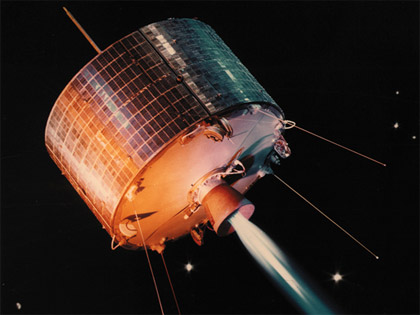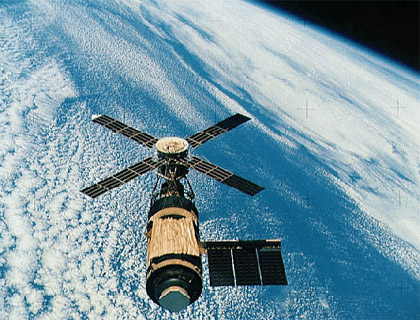Draper Laboratory: The Growing Menace of Orbital Debris
The world is critically dependent on satellites in Earth orbit for global communications, navigation, weather forecasts, environment and resource monitoring, and numerous security functions. But, imagine a world where such functions as hurricane tracking, climate change monitoring, communications in natural disaster zones, arms treaty verification and warnings of regional conditions, which can promote rapid spread of infectious diseases, were no longer viable. That could be the consequence in the future if we do not eliminate orbital debris.
Although active platforms that provide important capabilities from Earth orbit constitute a very small fraction of the man-made objects whizzing around the world, these platforms are at increasing risk from the ever-growing population of orbital debris. (Above image is showing how most orbital debris is in low Earth orbit, where the space station flies.)
Debris includes dead satellites, spent rocket stages used to launch satellites, pieces of spacecraft shed intentionally during satellite deployment or by accident, and many fragments of satellites and stages. The fragments have a variety of origins. Old rocket stages have sometimes exploded due to pressure from residual propellant. The Soviet Union sometimes intentionally broke up military spacecraft at the end of their life, and its satellites with nuclear reactors shed liquid sodium coolant. Some intentional orbital collisions have occurred to demonstrate anti-satellite weapons. And, now we have started to see accidental collisions of orbital debris with operational spacecraft.
Those collisions may be an initial manifestation of the Kessler Syndrome. More than 30 years ago, Donald Kessler predicted that as the debris population grew in Earth orbit, collisions would occur, creating more debris, resulting in increased collision frequencies with associated growing risk to spacecraft.
A related problem is the physical impact on the Earth’s surface of debris objects from spacecraft, which do not completely burn up in the atmosphere when they fall out of Earth orbit. The reentry and breakup over the Pacific Ocean of the 6.5 ton Upper Atmosphere Research Satellite on September 23, 2011, for example, garnered international attention from the media because of a very small but finite risk that the debris could have landed in populated areas. More consequential was the Soviet Cosmos 954 satellite reentry on January 24, 1978, because it spread pieces of a spent nuclear reactor over a wide area in the Canadian Northwest Territories, which necessitated a 9-month cleanup operation to prevent subsequent harm to humans and the environment!
Contributing Threats
The velocity of an orbital object makes its collision with another object potentially lethal. Spacecraft in Low Earth Orbit (LEO) move at 7500 m/sec. Orbits of objects are in different planes around the Earth and at different inclinations (the angle of the orbit with respect to the equator).

Photo Credit: NASA|Image of Syncom communications satellite, which NASA began developing in 1960.
Consequently, these fast moving objects generally do not move in parallel but instead often approach each other at steep angles. When they hit, they can collide at very high relative speed, sometimes even faster than the orbital speed of each object. The energy release of collisions is like a giant explosion that fragments the colliding objects and creates a spreading cloud of new debris, with each piece ending up in a unique, altered orbit. A Chinese anti-satellite test in 2007 created thousands of debris objects. In 2009, an unpredicted collision of a live Iridium satellite and a dead Russian satellite created thousands more debris objects.
Debris in orbit can remain for very long times. When an object is in a very low orbit, drag effects of the thin upper atmosphere of the Earth cause a gradual loss of altitude and eventual reentry of a spacecraft. As the altitude of the orbit increases, these effects decrease rapidly, thus making the typical life of an object in orbit decades to centuries.
Given the energy of orbiting debris, an object as small as one centimeter can be deadly to a satellite with which it collides. The current space surveillance state-of-the-art for debris tracking can monitor objects bigger than 10 cm in LEO. It is estimated that there are more than 500,000 orbiting objects that are in the one cm class.
Sophisticated models of the current LEO environment indicate that it is now unstable. That means that even if all launch activity were to stop, satellite collisions with debris will occur. That collision frequency is now projected to result in one major accident involving a live satellite about every five years but will increase in frequency as collisions increase the number of debris objects. Continued launch activity without debris removal will make LEO more unstable, accelerating collisions. Absent dedicated responses and mitigation, the expected survival time of any spacecraft in LEO could eventually become too short to justify its launch.
Limited Action in Process
Limited actions are already being taken to reduce the likelihood of satellite collisions. Application of standards by some countries now reduces generation of debris from newly launched objects. This is accomplished by satellite designs that avoid intentional shedding of objects that remain in orbit. New, spent rocket boosters are now vented at the end of their mission to prevent their subsequent explosion in orbit. Efforts are also underway to improve surveillance of space objects to better predict potential collisions. This would allow live spacecraft with maneuver capability to better evade objects with which they are at risk of collision. However, none of these measures reduce the number of objects already in orbit, prevent collisions of dead objects or stop generation of debris from intentional anti-satellite weapon tests. Also, since objects smaller than 10 cm are not now seen and tracked, their collisions with spacecraft cannot be anticipated and evaded.
Proposals have been made to require satellites to remove themselves from orbit within a defined time after their mission completion (e.g., 25 years). However, few satellite operators want to reserve some of their limited on-board propellant supply to accelerate de-orbit of a spacecraft, and other methods that might accelerate dead satellite orbital decay have not generally been applied yet.

Photo Credit: NASA|Skylab above the Earth as seen during the Skylab 4 mission.
The National Space Policy of the United States released on June 28, 2010, addresses preservation of the space environment through debris prevention and situational awareness improvement. It also directs NASA and the Department of Defense to pursue research and development into how to mitigate and remove oribital debris. Included in the NASA response is creation of a National Research Council Committee for the Assessment of NASA’s Orbital Debris Programs that is reviewing NASA’s initiatives to address and mitigate the effects of meteoroids and orbital debris both in Earth orbit and upon reentry.
Long-Term Solutions Needed
In the long term, the only solution to assuring that LEO remains safe is to find means to remove debris, thus addressing both the technical and political challenges posed by implementing solutions to the menace. The following four recommendations are necessary steps to begin tackling orbital debris issues:
- Put new international law and/or agreements into place. Under current international law, debris remains the sovereign property of whoever launched it. Consequently, one nation cannot legally remove debris put into orbit by another nation without prior approval.
- Develop and demonstrate means to enable debris removal. This must be pursued to the point where the means are proven capabilities widely accepted by all space faring parties.
- Allow international oversight in implementation and monitoring of orbital debris mitigation technology. This is necessary to avoid disputes. Orbital debris removal is not just a technology problem because the debris removal systems may also have the potential of being used to harm or dispose of operational satellites.
- Fairly share the costs of debris removal. If the cost of debris removal multiplies the net cost of space operations for any single party, then it remains unattractive to address the debris problem. Means must be found both to cover the cost of debris removal and to share equitably that cost among all users of Earth orbit. Even a very economical debris removal system will have substantial net cost. Funding this will probably require additional international agreements, which would share the debris removal system costs across all spacecraft operators and maybe across users of services provided by the spacecraft as well.
Final Observations
If international policy issues can be addressed, then the necessary technology development and debris removal demonstrations can be pursued. Maximizing the amount of debris mass removed from orbit should be the initial objective, which can be accomplished, even with limited removal system capability, by focusing first on removing the limited number of large debris objects.
The good news is that awareness within the space operations community of the menace posed by orbital debris has increased greatly in recent years and many promising mitigation and removal technologies have been proposed. However, the problem cannot be systematically tackled without full political involvement of space faring nations to overcome the legal, economic and threat issues posed by debris removal. The bad news is that no clear path currently exists to overcoming the international political parts of the problem.

© iStockphoto.com/enot-poloskun




























